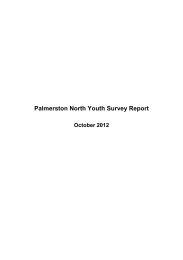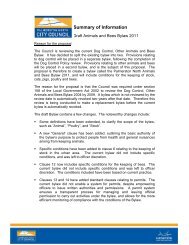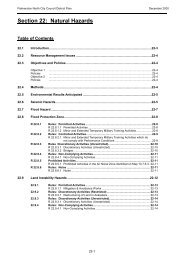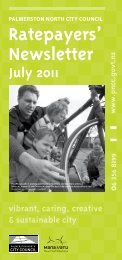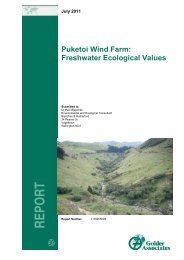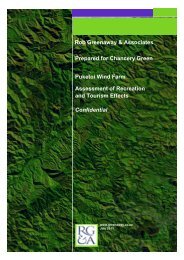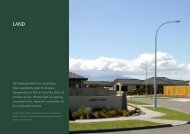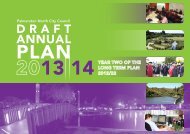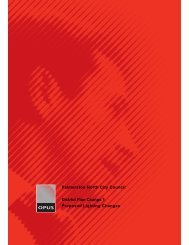Manawatu Journal of History - Digital Library
Manawatu Journal of History - Digital Library
Manawatu Journal of History - Digital Library
You also want an ePaper? Increase the reach of your titles
YUMPU automatically turns print PDFs into web optimized ePapers that Google loves.
Feilding was the dominant team for many years and it wasn’t until after 6 years, in 1884, thatPalmerston gained their first win over Feilding. The key figure in the improvement <strong>of</strong> thePalmerston team was the captain Ted Secker who was the outstanding player in the townduring the 80’s. The first organised club competition started in 1885 and the <strong>Manawatu</strong>Rugby Union formed the next year. Palmerston played annual fixtures with Wellington clubsduring the 80s and before the railway linked the towns the teams travelled by boat out <strong>of</strong>Foxton.Palmerston were usually beaten by the stronger Wellington clubs but the Wellington folkenjoyed receiving visits from Secker’s teams because Palmerston always provided veryenjoyable after-match entertainment. Known as ‘smoke-concerts’ players sang and did shortplays to amuse themselves during the evening. Secker’s troupe became renown as betterperformers at smoke-concerts than on the rugby field.A local accountant and very keen musician Ted Secker’s enthusiasm for entertainmentfostered friendships and team spirit. I suspect that the growth in popularity <strong>of</strong> the game waspartly the reason for the founding <strong>of</strong> the <strong>Manawatu</strong> Rugby Union in 1886. Secker was the repteam captain for the union’s first three years however the team failed to meet any onfieldsuccess. In the 7 games played they neither won a game or scored a single point. HoweverSecker did leave his mark on the game.During the week before a rep game in Wanganui he wrote the words for a new rugby songand while the team were travelling by train to Wanganui they sang the words to a well knowntune <strong>of</strong> the day. The players obviously liked the words and upon arrival back in Palmerstonthe local players gathered at the Club Hotel and Secker sat at the piano and composed themusic. The song was titled “On the Ball” and to honour the special respect he had for theFeilding captain Secker dedicated his song to Andrew Thomson.On the Ball became an instant hit with rugby teams around the country and the 1888 Nativeteam sang the rugby song during their long tour <strong>of</strong> Britain. Begg’s published the song manytimes over following decades, presenting special editions <strong>of</strong> the music sheet to All Blacktouring teams and also the 1945/46 Kiwis army team. Rugby’s most popular song wasincluded in school songbooks not only in NZ but also in South Africa.After the formation <strong>of</strong> the union in 1886 there was a steady growth <strong>of</strong> clubs during the early90’s and in 1896 the president Bert Hankins donated a shield for senior competition. TheHankins Shield is still the championship trophy today, the oldest trophy in NZ for any seniorprovincial club championship.The mid 90s saw new unions formed in Rangitikei and Oroua, both joining <strong>Manawatu</strong> assub-unions however by the late 90’s major disputes developed between <strong>of</strong>ficials <strong>of</strong> Feildingand Palmerston. Feilding strongly believed the union AGM should be held in Feilding toattract delegates from the Oroua and Rangitikei areas. Palmerston delegates resistedFeilding’s plans <strong>of</strong> becoming the base for <strong>Manawatu</strong> rugby. The result was a damaging splitbetween the towns. Feilding and the sub-unions joined Wanganui union and Foxton joinedHorowhenua. This left Palmerston with no opposition and the union failed to operate for acouple <strong>of</strong> seasons.Some Palmerston players travelled to Foxton or Levin for club rugby and a couple played forHorowhenua.In 1902 two clubs in Palmerston formed senior teams and applied to join Rangitikeicompetition but were refused entry. Rugby in the town could have died had it not been for
the arrival <strong>of</strong> a 22 year-old former Wellington rep Edgar Wylie. Wylie called a meeting <strong>of</strong>Palmerston footballers and several local clubs helped re-establish the <strong>Manawatu</strong> RU. Wylieacted as the union secretary and captained the rep team. Wylie returned to Wellington later inthe year and served on the NZRU and became a life member.Assisting the re-birth <strong>of</strong> rugby in Palmerston was the vicar <strong>of</strong> All Saint’s Church. RevHarper, a referee in Patea before arriving in town had formed a Junior RU the previous yearand re-established the Referee’s Assn. A widely respected figure Rev Harper was anexperienced referee and controlled the Inter-Island fixture <strong>of</strong> 1902. In those days the North-South game was the major domestic rugby fixture.Kia Toa club began in 1902 but the most significant introduction was the opening <strong>of</strong> thePalmerston High School. For the first time the region had a rugby nursery and over thefollowing years played an ever increasing roll in local rugby. School leavers joined localclubs having already considerable knowledge and experience <strong>of</strong> the game. Frank Foote, aformer Otago rep, was an early master at the High School and became heavily involved inunion affairs. Boys High staff have over the years made a big impact on rugby in our region,none more so than the late Ian Colquhoun.Feilding made several attempts to re-join the <strong>Manawatu</strong> union but were refused entry untilbeing admitted in 1905. Perhaps the wounds <strong>of</strong> earlier years had yet to heal.The union was very strict on players conduct. Fighting on the field or arguing with thereferee resulted in heavy suspensions. In 1905 the union arranged its first South Island tourwith 4 games to be played and having experienced some <strong>of</strong>f-field troubles with players theunion demanded 2 Pounds from each player as a good-conduct guarantee. With the averageworking man’s wage being about 1 pound a week this was a considerable bond to pay theunion. The team refused to pay and the tour nearly called <strong>of</strong>f. Just a couple <strong>of</strong> days beforescheduled departure the players elected to pay. The union may have been justified for theirstance as late in the season some team members did 5 pounds worth <strong>of</strong> damage in aWellington hotel. Four players were given suspensions ranging from one year to a life-ban.These problems with players were not confined to <strong>Manawatu</strong>. All unions experienced similarproblems. In those days <strong>of</strong> rugby touring many players were venturing outside their districtfor the first time. It was an exciting opportunity to see the country. Post-match celebrationshas always been a part <strong>of</strong> rugby and continues to this day.<strong>Manawatu</strong> rugby battled on until the outbreak <strong>of</strong> WW1 when so many young men entered thearmy. During the war senior club rugby was restricted to just a few club teams and armyunits based at Awapuni and Rangiotu. Schoolboy rugby, however, remained strong. Prior tothe war, rugby nationally was greatly threatened by the growth <strong>of</strong> a new code, rugby league.Many players, even clubs, switched to league. Thankfully, our military leaders allowed onlyrugby union be played among the services and so league received a setback. During the1920’s rugby entered a new era <strong>of</strong> popularity, highlighted by the visit <strong>of</strong> the 1921Springboks, great Hawke’s Bay Ranfurly Shield era, and the 1924 All Blacks tour <strong>of</strong> Britain.League was always a threat, particularly during the years <strong>of</strong> the economic depression <strong>of</strong> the30s.From the earliest times rugby has been played at the Showgrounds while in Feilding andFoxton games were played at the racecourse. Palmerston teams would travel to Foxton bytrain which ran down Pioneer Highway to Himatangi then alongside SH1 to Foxton. BetweenFeilding and Palmerston horse-drawn coach was the popular method.
The Sports Ground in Fitzherbert Avenue was frequently used until the late 1920s when theunion purchased 20 acres in Park Road, now known as Ongley Park. In Feilding JohnstonPark was opened in 1928.Facilities for early players were basic. The nearest horse-trough was the common site forgetting rid <strong>of</strong> the mud. Most clubs used a hotel as a base and no doubt provided some teamswith warm baths. Showers weren’t installed at the Showgrounds until 1905. It wasn’t untilthe 1950s and 60s that clubs were in a financial position to own their own clubrooms. Therep team first wore maroon jerseys. The present day strip <strong>of</strong> green with the tram-lines wasfirst worn exactly 100 years ago, in 1908.Newspapers gave excellent coverage <strong>of</strong> club and rep rugby, there were very few other sportsbeing played then. Players were informed <strong>of</strong> rep selection by the newspaper. Very seldom didthe selected team take the field as many players, particularly those in the country, would notsee the paper. Others couldn’t play due to work commitments.Club rugby attracted much greater interest than it does today. There were no otherdistractions, no television, and very few other recreational activities. The rivalry betweenPalmerston and Feilding teams has always been strong, right up to recent years.When Palmerston club disbanded Ted Secker was a supporter <strong>of</strong> Kia Toa and whenever theteam had a win outside Palmerston it became a habit for the team to drive to Secker’s street,stop outside his home and sing “On the Ball” which was the signal that Kias had won.The most notable administrator <strong>of</strong> the period was Joe Ongley, a former rep captain, who ledthe union during the 20s and 30s. He was a well known lawyer.It is difficult to single out the best players. But Archie McMinn, a son <strong>of</strong> the founder <strong>of</strong> the<strong>Manawatu</strong> Standard, was probably the most skilful player <strong>of</strong> his era. A tall man (6ft 5in) hewas regarded by the Australian press as the most outstanding forward on the unbeaten 1903New Zealand team in Australia. He was a giant but had good hands, a huge punter and anexcellent dribbler <strong>of</strong> the ball. Had McMinn toured Britain with the 1905 All Blacks he wouldhave stood head and shoulders above his team-mates and most likely come home as the starforward <strong>of</strong> the tour and one <strong>of</strong> our greatest All Blacks. Unfortunately for NZ rugby, ArchieMcMinn was a rough diamond and he would not have met the strict code <strong>of</strong> conduct whichthe NZRU had set before tour selection.During the 1920s no player stood taller or was more highly respected than Harry Jacob. LikeArchie McMinn he was a superb wing forward, athletic, hard and fast. He lived at Levin butwhen <strong>Manawatu</strong> and Horowhenua unions combined in 1925 to play as Manawhenua HarryJacob captained the team for three years, the greatest moments being the three defences <strong>of</strong>the Ranfurly Shield in 1927. He had played for Horowhenua from the age <strong>of</strong> 16, decoratedwith the Military Cross during WW1, the star player <strong>of</strong> the Maori Battalion team, and an AllBlack in 1920. A dairy farmer, he was unavailable for several games and tours. He was themost devastating wing forward <strong>of</strong> his time but the reasons for his non-selection for the 1924All Blacks remain a mystery. Some say he had made himself unavailable, yet theHorowhenua RU wrote to the NZRU complaining about the poor treatment <strong>of</strong> Jacob duringthe Trials. Jacob did play in the final trial but missed selection. A story circulated that theselectors wanted the smaller, and less experienced Cliff Porter as captain. Porter was also awing forward but Jacob would overshadow the Wellington player. Jacob was a much moreexperienced captain than Porter but there were doubts that the English would approve <strong>of</strong> NewZealand sending over a team captained by a Maori. Had Harry Jacob played for a majorunion and not been a Maori I’m sure he would have been one <strong>of</strong> our greatest All Blackleaders.
Well known local publican Ollie Galpin who played both against and alongside Jacob in somany rep games during the 20s told me Harry Jacob was by far the best player he knew and areal gentleman. My impression from interviews with his family and those who played withhim is that Harry Jacob was a 1920s model <strong>of</strong> Sir Brian Lochore. Perhaps the only differencewas that Jacob was the more dominant and imposing figure on the field.Mention <strong>of</strong> Jacob maybe detracting a bit from the story <strong>of</strong> early <strong>Manawatu</strong> rugby but heplayed as many games for the combined team as he did for Horowhenua. Whenever a touringteam visited NZ and played in Palmerston <strong>Manawatu</strong> always combined with Horowhenua.This continued right up to the 1970s when we had the farcical situation in 1977 when, asholders <strong>of</strong> the Ranfurly Shield, <strong>Manawatu</strong> met the Lions and had to change the successfulsquad to accommodate some Horowhenua players. Eventually the NZRU saw sense and thefollowing year <strong>Manawatu</strong> defeated a very strong Wallaby test team which went on to win thetest series against the All Blacks.Visits by the Lions and Springboks were major events for Palmerston with locals crowding atthe Railway Station to welcome the team. The largest crowd to watch a game at theShowgrounds was in 1959 for the Lions game when the <strong>of</strong>ficial figure given was 24,996.********************************************************************************************************************************It has been well documented that the first game <strong>of</strong> rugby played in New Zealand took placeat Nelson in 1870. From there the game rapidly spread to other centres – Wellington,Wanganui, Auckland, Thames, Christchurch, Dunedin – and eventually to Palmerston Northand Feilding in 1878. It is also well known that the man who introduced the rugby rules toNew Zealanders, Charles Monro, spent most <strong>of</strong> his life in Palmerston North. But it is lesserknown that two other men responsible for staging that historic first game later settled in thedistrict. Alfred Drew’s contribution as a pioneer and promoter <strong>of</strong> rugby has largely beenignored, even by rugby historians, so too is the part played by Robert Tennent. All three menshared an interest in rugby but in later years their interests turned to music and eachparticipated in opera and musical activities which were popular at the time.In addition to Monro, Drew and Tennent a fourth rugby player, Ted Secker, made his mark inPalmerston North as the writer and composer <strong>of</strong> rugby’s best known song, “On the Ball”.After three years at Nelson College, 16 year old Charles Monro went to London in 1867 toattend Christ’s College as preparation for a career in the army. There he played rugby but hedisliked London and it was felt he was not robust enough to join the army. He returned toNelson early in 1870.While Monro was away Robert Tennent initiated and founded the Nelson Football Club in1868, the new club playing a version <strong>of</strong> Victorian football which immigrants from Australiahad brought with them. Alfred Drew, another Nelson College old boy, was captaining theclub team when Monro returned with the suggestion that the club change to the rugby ruleshe had learnt in England. After a practice the club approached the headmaster at NelsonCollege who was familiar with the rules as he himself had come from Rugby School inEngland where the rules had originated. The historic game was played on May 14, 1870,Monro, Tennent and Drew participating with Drew kicking the first goal to become the firstpoint scorer in New Zealand rugby. Nelson Club defeated the College team 2 goals to nil.Nelson Club changed its constitution and adopted the rugby rules. Tennent became the first
secretary-treasurer, Drew the chairman and club captain, and Monro the coach andcommittee member.Later that year while Charles Monro was in Wellington staying with his father, prominentpolitician Sir David Monro, Tennent wrote to Charles asking him to arrange a match inWellington for the Nelson team. Charles managed to muster up a team including severalfrom the local armed constabulary, found a field in Petone suitable for a game, and the firstrugby game played in the North Island was staged on September 12 th . Monro played anunusual part in the game, he being selector and coach <strong>of</strong> the Wellington team, refereed thegame, and played alongside Tennent and Drew for Nelson.Monro and Tennent continued to play for Nelson over the following years. Meanwhile,Alfred Drew moved to Wanganui in 1872 to join his brother and commence a career as awatchmaker and jeweller. He introduced rugby to the locals and the first game was played inJune that year, Wanganui becoming the third region, after Nelson and Wellington, to adoptrugby. From that event rugby gradually moved down to Turakina and Rangitikei by 1876 andinto the <strong>Manawatu</strong> in 1878. Drew was only in Wanganui briefly and soon moved on to NewPlymouth to establish his own business and in 1874 organised the first rugby game inTaranaki. Drew moved his business to Palmerston North in 1886 and though he had retiredfrom active rugby he continued to serve the game as a referee. He was a foundation member<strong>of</strong> the Palmerston North Bowling Club and was its third secretary and later honoured withlife membership. One year he won a North Island title.Robert Tennent was a relative <strong>of</strong> Thomas Arnold. The 19 th century classic, “Tom Brown’sSchooldays”, written by Thomas Hughes was about life at Rugby School during the periodwhen Arnold was headmaster there. Tennent had a career with the Bank <strong>of</strong> New Zealand andwas transferred from Nelson to Patea where he played in the first Patea team in 1876. Furthertransfers saw him in Wanganui, Wellington, Auckland, Blenheim, Dunedin, Timaru, andfinally Invercargill before retiring about 1919. He was keen on Gilbert and Sullivan operasand was remembered in Patea for his performance in “Pirates <strong>of</strong> Penzance”. A keen golfer hehelped form courses at Timaru and Otatara (Invercargill) and played bowls in Napier andWoodville, where he spent his latter years.Charles Monro was a son <strong>of</strong> one <strong>of</strong> the first Scottish immigrants to New Zealand, DavidMonro, who settled in Nelson in 1842 and married Dinah Secker in 1845. Charles was bornin 1851 and later farmed the family properties while his father was in Parliament. DavidMonro, knighted in 1866, was a long time speaker <strong>of</strong> the House before retiring in 1873. Hedied in 1877. Charles moved to Palmerston North in 1886 and purchased 50 acres across the<strong>Manawatu</strong> River where Massey University is now sited. His homestead, Craiglockhart, laterbecame a student hostel. In addition to his farming activities Monro had interests in timbermilling,flax-milling and introduced the Japanese plum to New Zealand. He was an authorityon river protection and erosion control. His sporting interest was golf and he became afounding member <strong>of</strong> the <strong>Manawatu</strong> Golf Club, being its first club captain and president. Theeighth hole is named in his honour.Monro and Drew would have met each other <strong>of</strong>ten in Palmerston North as both shared a lovefor music. Monro sang at operatic shows being particularly popular with his ability to singarias in Italian. One <strong>of</strong> the features <strong>of</strong> Craiglockhart was a high ceiling (a 15ft stud) built withgothic arches, l<strong>of</strong>ted like a small cathedral. Monro intended that the room be used foroperatic recitals, and indeed, it was once used for a concert by a visiting Italian opera troupe.Drew was one <strong>of</strong> four men who founded the Palmerston North Orchestral Society in 1894and conducted the orchestra and also the Choral Society. When the district’s first pipe-organwas installed in All Saints’ Church, in 1892, Drew was the first appointed organist and he
emained in that position for some 25 years. In later years Drew decided to move toWhangarei to be near two <strong>of</strong> his daughters but after four years, and his health failing him, hereturned to <strong>Manawatu</strong> in 1925 to spend the last few months <strong>of</strong> his life with son King whowas clerk to the <strong>Manawatu</strong> County Council. Alfred Drew died at Sanson on 13 February,1925, aged 75.Charles John Monro lived to the age <strong>of</strong> 82, passing away on 9 April, 1933. Robert CollingsTennent was the last <strong>of</strong> the rugby pioneering trio to pass on, he died at Woodville on 14April, 1939, aged 90 and is buried at the old cemetery just through the <strong>Manawatu</strong> Gorge.That the three men instrumental in starting the rugby game in New Zealand are buried locallyis a coincidence but while the Monro grave site is appropriately marked as the founder <strong>of</strong>New Zealand rugby, the other two sites should also be identified as significant historical sites<strong>of</strong> our national sport.When the <strong>Manawatu</strong> Rugby Union was formed in 1886, its first captain was 25 year-oldEdward ‘Ted’ Secker. For many years he had been captain and secretary <strong>of</strong> the town’s solerugby club, Palmerston Football Club, but in the three years he captained the <strong>Manawatu</strong>representatives (1886-88) his team not only failed to win a game, they failed to score a singlepoint! But Secker unwittingly made a big contribution to the game and society by writing andcomposing a rugby song which became popular both in New Zealand and overseas. The songhe composed, “On the Ball”, while sitting at the piano in the Club Hotel places him,alongside Monro, Drew and Tennent, as a noteworthy pioneer <strong>of</strong> rugby who lived in the<strong>Manawatu</strong> district.Born in London in 1861, Secker immigrated to New Zealand in 1881 and settled in Bulls fora brief period before shifting to Palmerston North where he worked as an accountant forStevens & Gorton and later Barraud & Abraham. In 1887 he worked for W. Luxford who hadjust established a produce and general merchant business next door to the Club Hotel, inChurch Street. Secker purchased the business in 1894.Exactly what year “On the Ball” was written had never been stated by Secker or his familyand several letters and interviews published in local papers during 1935 never gave a definitedate. One writer indicated the song was written in the 1890’s, another as early as 1885. InAugust 1935 a letter written by ‘JUSTICE’ was published claiming that a Nelson countryschoolteacher, Reginald Hodder, wrote the song during 1890-91. ‘Justice’ wrote in greatdetail how, as a senior pupil at the school, he remembered the pleasure Hodder got whenviewing his freshly printed manuscript alongside his original draft and that Hodder taught hispupils the song. Hodder himself was a former rugby player having represented Nelson in1884 while attending Nelson College. He later moved to England where he died in 1929.However, all the other readers who wrote to the Evening Post, many <strong>of</strong> them former playersand friends <strong>of</strong> Secker, stated that Secker was the composer and the manuscript published byBegg’s was clear pro<strong>of</strong>. The song’s origin was again questioned during the mid 1950’s withanother flurry <strong>of</strong> letters to the Evening Post which prompted Secker’s daughter, Mrs MurielRussell <strong>of</strong> Linton, to write to the paper to correct some facts made by other writers and later,in 1966, provided information to <strong>Manawatu</strong> Standard reporter John Mancer (publishedOctober 1). Mrs Russell recalled that, as a child, she remembered the Kia Toa club teamsinging the song outside her home whenever the team returned from Feilding victorious.In those early days rugby after-match functions were much different from today. Teamsdined together after a match and players were expected to entertain with skits, singing or play
music. These social occasions were known as ‘smoke concerts’ and any team that Secker wasinvolved with were well known for their entertainment. On annual trips to Wellington thePalmerston or <strong>Manawatu</strong> team were welcome visitors as their smoke concert performancesusually exceeded their rugby efforts. Secker was an accomplished, self-taught pianist, a finesinger and <strong>of</strong>ten recited poetry he himself had written, for he was a keen student <strong>of</strong> CharlesDickens.The team <strong>of</strong>ten did not have a manager, it being the responsibility <strong>of</strong> the appointed captain toorganise meetings and travel. The union would select a team and publish it in the newspaper,leaving the captain in charge to ensure everyone turned out on match day.From the information contained in the many letters to newspapers and the details provided byMrs Russell and other members <strong>of</strong> the Secker family I managed during the early 1980’s toidentify exactly when “On the Ball” was composed.On Saturday, 10 September, 1887 <strong>Manawatu</strong> was to travel to play in Wanganui for the fourthand final match <strong>of</strong> the season. The team was selected from the union’s three clubs –Palmerston, Foxton and Feilding. During the week Secker, instead <strong>of</strong> ensuring his players beat the railway station at correct times, was preparing his team’s skits for the post matchsmoke concert. On the Thursday he wrote a poem ‘Happiness, Only a Dream’. On Friday,while sitting in his employer’s <strong>of</strong>fice, next to the Club Hotel in Church Street, he wroteanother poem and finding that it rhymed with ‘We’ll All Go A Hunting Today’, added achorus and then produced several copies.Early next morning Secker arrived at the railway station to catch the train to Wanganui butno one from Foxton had appeared, then when the train stopped in Feilding, no Feildingplayers were there to join the team. So Secker’s <strong>Manawatu</strong> team arrived in Wanganui withjust 12 Palmerston Club members and so as an even match could be played, Wanganuiloaned three players for Secker’s side. <strong>Manawatu</strong> lost 2-0 but as usual won the smoke concertentertainment. No doubt the players appreciated the words <strong>of</strong> Secker’s poem and encouragedhim to extend the poem, which he did by adding two more verses.The Club Hotel was the ‘clubrooms’ for Palmerston rugby players and during the eveningsfollowing the Wanganui trip Secker sat at the piano and developed the poem into a songwhich became “On The Ball”. Before sending the manuscript to Chas Begg & Co in Dunedinfor publishing he dedicated the song ‘To Andrew D. Thomson, An Old Opponent and GoodFriend’. Thomson was the outstanding player in Feilding, just as Secker was in Palmerston,and the two rival captains developed a deep respect for each other during the frequent rugbycontests. Thomson was the magistrate in Feilding and later in Palmerston North.The actual date Begg’s published “On the Ball” is not clear but could have been as early as1889 or 1890. The Native Team who toured the world for 15 months during 1888-89 sangthe song at nearly every function they attended but it is believed they did not carry musicsheets. The team, comprising almost entirely <strong>of</strong> Maoris, were very popular entertainers withtheir fine voices, particularly in England. Sheet music would have been foreign to most <strong>of</strong> theplayers. The 1893 New Zealand team, the first <strong>of</strong>ficial NZRFU selection, took the song toAustralia and when the 1905 All Blacks toured Britain a Palmerston North resident, OssieClelland, went as a supporter, taking with him a signed copy <strong>of</strong> the Begg’s sheet music foreach team member. “On the Ball” was again popular, so popular that one <strong>of</strong> England’s mostdistinguished sportsmen, Charles Fry, cabled Secker asking to buy the copyright. Secker didnot respond.Begg’s published the song several times, a second edition was produced either in 1905 orabout 1908. Another edition was done in1935 with a copy given to each <strong>of</strong> the All Blacks
touring Britain that year and a decade later a special edition was produced for the 1945-46Kiwis Army rugby team for their tour <strong>of</strong> Britain, France and Germany. “On the Ball” hasbeen included in school song books for decades and not only in New Zealand. A SouthAfrican now living in Palmerston North recalls singing the song at his school in SouthAfrica.It has only been in more recent times, since the emergence <strong>of</strong> radio and taped music that thesong has waned in popularity. Team singing has been replaced by stereos, disco music, rockbands etc. However the song has not been completely forgotten – at one <strong>of</strong> the last testmatches played at Wellington’s Athletic Park the brass band played the tune during the halftimebreak.Ted Secker wrote another song called “Rugby Ev’ry Time” which was published by W.H.Paling & Co Ltd about 1914 but this never matched the popularity <strong>of</strong> “On the Ball”. Duringthe past 20 years I’ve made several suggestions that <strong>Manawatu</strong> rugby adopt the song as the<strong>of</strong>ficial <strong>Manawatu</strong> rugby song but without success. If the song was blasted through thespeaker system at FMG Stadium it would certainly warm the hearts <strong>of</strong> old-timers and theyounger generation, if they were aware <strong>of</strong> its origin, could revive the once well known song.Edward Walter Secker moved from Palmerston North during World War I to Nelson wherehe died at the age <strong>of</strong> 65 on 21 February, 1927.ON THE BALL1 Oh some talk <strong>of</strong> Cricket and some <strong>of</strong> Lacrosse,Some long for the Huntsman’s loud call,But where can be found such a musical sound,As the old Rugby cry, “On the Ball.”ChorusOn the Ball! On the Ball! On the Ball!Thro’ scrummage, three-quarters and all,Sticking together we keep on the leather,And shout as we go, “On the Ball!”2 On a cold wintry day, when the ball is away,Let sluggards at home then remain,We’ll kick and we’ll follow, we’ll run, pass, and collar,As we shout the same merry refrain.3 This life’s but a scrummage we cannot get through,But with many a kick and a blow,And then in the end, tho’ we dodge and we fend,Still that sure collar “Death” takes us low.4 But altho’ brought down, there remains still a chance,To pass if we play the right game,And the poor weary soul may at last win that Goal,Which is ev’ry true Footballer’s aim.5 Remember then boys, as we journey through life,There’s a Goal to be reached bye and bye;And he who runs true, why he’s bound to get through,And perhaps kick a Goal from his try.
Bibliography:They Gave Us Rugby, by Alan Turley, 1996.100 Years <strong>of</strong> Rugby – Story <strong>of</strong> Nelson RFC 1870-1969, by W.A. Reed.<strong>Manawatu</strong> Rugby – The First 100 Years, by Clive Akers, 1986.



